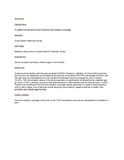| dc.contributor.author | Owino, LO | |
| dc.contributor.author | Irimu, G | |
| dc.contributor.author | Olenja, J | |
| dc.contributor.author | Meme, JS | |
| dc.date.accessioned | 2014-04-29T04:40:07Z | |
| dc.date.available | 2014-04-29T04:40:07Z | |
| dc.date.issued | 2009 | |
| dc.identifier.citation | Owino, L. O., G. Irimu, J. Olenja, and J. S. Meme. "Factors influencing immunisation coverage in Mathare Valley, Nairobi." East African medical journal 86, no. 7 (2009). | en_US |
| dc.identifier.uri | http://www.ncbi.nlm.nih.gov/pubmed/20499781 | |
| dc.identifier.uri | http://hdl.handle.net/11295/66115 | |
| dc.description.abstract | OBJECTIVE:
To determine the factors that influence immunisation coverage.
DESIGN:
Cross section destrictive study.
SETTING:
Mathare valley slums in Central district of Nairobi, Kenya.
SUBJECTS:
Seven hundred and twelve children aged 12-23 months.
RESULTS:
Access to immunisation services was excellent at 95.6%. However, utilisation of immunisation services was found to be suboptimal as indicated by the low fully immunised child (FIC) percentage of 69.2% and the high drop out rate between the first and third Pentavalent vaccine coverage by card or history (12.0%). The immunisation status of the study population is significantly influenced by the maternal age (p-value < 0.001), ethnicity (p-value 0.009) and presence of child welfare card at home (p-value < 0.001). Factors that contribute to the low immunisation coverage include ignorance on need for immunisations and on return dates, fear of adverse events following immunisation, negative attitude of health care providers and missed opportunities.
CONCLUSION:
The immunisation coverage in the area is low. The immunisation services are accessible but utilisation is poor | en_US |
| dc.language.iso | en | en_US |
| dc.publisher | University of Nairobi | en_US |
| dc.title | Factors influencing immunisation coverage in Mathare Valley, Nairobi | en_US |
| dc.type | Article | en_US |


